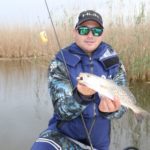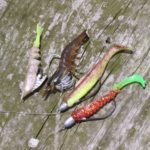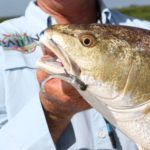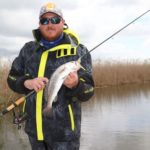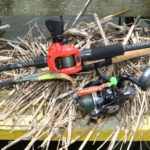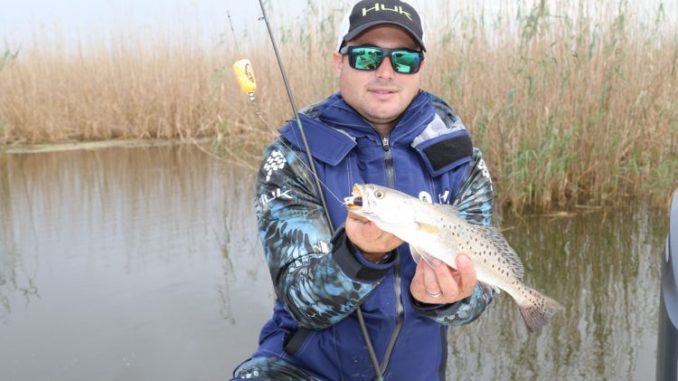
Winter in Southeast Louisiana is unpredictable – and so are the fish. Keep these tips in mind when you’re targeting specks and reds now out of Venice.
Step outside and the chilly winter air stings your nose and ears. What do you do? You grab a jacket, gloves and maybe a neck gaiter. Pretty standard stuff, but fish have no such options. They gotta deal with whatever nature throws their way by being smart and seeking refuge in life-sustaining habitat.
Fortunately, the vast Mississippi River Delta abounds with such cold-weather sanctuaries that keep redfish and speckled trout warm during winter’s chill. Some are more obvious than others, but this estuarine wonder often rewards anglers who realize the differences between these top-billing species.
“As a given, reds are almost always active and catchable in the winter,” said Capt. Anthony Randazzo, of Venice-based Paradise Plus Guide Service. “Specks, on the other hand, are susceptible to lockjaw when water temperatures plummet and barometers skyrocket. It may take three days for specks to recompose themselves after a sharp cold front, whereas redfish will bite before, during and after the fronts.”
Mississippi River level is key
According to Randazzo, specifics of winter fish location can be very dynamic based upon the river height and corresponding salinity levels. The southern terminus for one of the nation’s largest drains answers to many upstream influences, so fluctuation is the norm.
“The higher the salinity, the more likely the multitudes of speckled trout and redfish will be drawn to the winter wonderland of the main river system,” Randazzo said. “When this scenario is present, we catch lots of specks and reds — not to mention some of the most consistent stringers of the year in the river itself.
“The fish have all of the comforts of deep water, moving water, fresh and saltwater forage, and a variety of structure to keep them pacified. When the river stays low for extended periods of time as it did in 2000 and 2001, the specks and reds can be caught many miles upriver from Venice, not just in the lower Delta.
“Unfortunately, Old Man River throws us a few curveballs, and we have to make adjustments to remain consistent. The redfish may find the lower salinities acceptable and remain near the main river or slightly closer to the open water of the coastal bays within the tributaries of the Mississippi River. However, the specks will move away from the lower salinities quite rapidly and flee to the coastal bays where conditions are preferable.”
Randazzo goes on to say that, if river salinity remains low, it will force the specks in the coastal bays to migrate along the coast in search of warmer bait-filled backwaters as a second choice for winter solace. Many trout, he said, will push as far north and inland as possible in search of the warmest bays and bayous, where they are also more likely to find clean water after frequently passing cold fronts.
Depth rules
Spring through fall sees a more gracious and forgiving Delta, as redfish roam just about every grass edge, duck pond and roseau cane island, while trout can be found from open water oyster reefs to passes, flats and nearshore rigs. But the challenge of finding fish intensifies when winter inflicts harsh weather restrictions and shrinks the playing field. If there is one consistent element of winter fishing it’s this: the greater the depth, the greater the stability.
“When fishing in the river system we are focusing on flats adjacent to deep water, eddies in the deep water, points/cuts along the river and its tributaries and rock structures along the river banks that may or may not extend out into deeper water,” Randazzo said. “When the fish opt for the coastal bays and marshes of the Delta, we are targeting deeper natural channels that connect the bays, pipeline canals that are able to stay protected from the wind and flats that contain oyster shells (shell bottoms warm quickest on cold and sunny days).”
For most of his winter marsh fishing, Randazzo likes a 4-inch Bass Assassin Sea Shad on a 1/8- to ½-ounce unpainted jig heads for speckled trout and redfish. When the water is stained or cold and the fish need a little extra incentive, he sprays his lures with Bang fish attractant.
Following a similar game plan, Delta guide David Iverson said marsh habitat with deep cuts and canals flanked by skinny flats with grass lines, shell and other common feeding features are golden for the copper brutes. Bottom line: The ability to feed, while maintaining proximity to stable water, makes a redfish very happy.
“Those redfish will come out of the marshes and get in those areas when it’s really cold; but if it’s not really cold, they’ll stay up in the shallows in the same places they were the rest of the year,” he said. “But when it does get really cold, they’ll look for a little area with 4 or 5 feet of water or better, where they can hang out until the weather warms up.”
When he’s searching for chilly redfish, Iverson likes a Bomber Who Dat spoon and a Bomber Model A crankbait. The classic gold spoon is a stalwart anywhere redfish swim, but Iverson said the gold with orange accent matches common redfish forage.
“If you look closely at the crabs and the cocahoe minnows, most of them have a little tinge of orange or red in them,” he said. “When you add that little bit of orange flashing back and forth in that spoon, it looks like (what redfish eat).”
Iverson likes the Model A in chartreuse with blue back, or any crawfish colors. He’ll crank this lure along marsh grass edges and pay particular attention to the areas outside the mouths of marsh drains, which serve as redfish food funnels on falling tides.
“If I get a bite or two on the crankbait or spoon, I might go back through with a grub or a Bomber Paradise Popper Xtreme cork rig,” Iverson said. “With the Paradise Popper, I’ll fish the 4-inch YUM Houdini Minnow (black back with glitter) on a ¼-ounce Bomber chartreuse head and an 18-inch leader.”
For the deeper holes where redfish settle during cold spells, Iverson casts a Bomber Mullet into the depths to entice active fish. He’ll use a jigging motion to probe these cold weather refuges.
Elsewhere, Capt. Joe Dimarco of Cajun Fishing Adventures in Buras often searches for reds throughout the network of canals cut for the oil and natural gas industry. Noting that he’s particularly fond of dead-end canals with prominent well heads, valve stations (aka “Christmas trees”) and various other structures, he’ll throw a selection of artificial shrimp and minnow-style jigs.
Work all reachable sides of a canal structure and know that the larger ones with decks and walkways offer overhead shelter that fish may favor during bright, post-frontal days. Skip your bait underneath the cover to see what’s lurking in the shadows.
When trout top Capt. Ross Montet’s target list on a cold winter’s day, the Cajun Fishing Adventures guide leverages natural Delta features like turns or elbows in canals or bayous, which hold a deeper pocket on the outside bend. Trout hold in these areas and the most inconspicuous of pockets can offer a gold mine of opportunity.
Direct casts with light jigs or artificial shrimp and let the baits slowly flutter through the target zone. Work your bait with the slow, fluttering movements to mimic cold-stunned baitfish or the occasional twitch-and-descend of a live shrimp.
“I’ll also fish my bait under a popping cork, because this lets you pause your retrieve and hold your bait in the strike zone longer,” Montet said.
Wind protection
In addition to the depth consideration, winter success also takes into consideration wind exposure. A windward location may not only be difficult to fish, it could require a rougher-than-you’d-like run on the way or returning. On the flipside, calm winds may bring distant options into play.
Strategic winter spots include:
• Garden Island Bay: Located on the northeast side of South Pass, shallow roseau cane-lined shorelines and points offer classic redfish habitat that’s protected from the strong north winds associated with winter fronts. Direct tidal influence from the Gulf of Mexico keeps the salinity high. Randazzo prefers low water and rising tides.
Here, Randazzo likes a Heddon Swim’n Image or a 3 ½-inch YUM Wooly Bug on 3/8-ounce jig head, either alone or under a Bomber Paradise Popper Xtreme float. They also work well along the eroded points.
• Southwest Pass: Deep water offers warm habitat with ample food, while the jetties provide protection from northwest to east winds. Randazzo uses his side imaging sonar to locate fish and targets them with soft plastics on ½-ounce jig heads tipped with bait shrimp. Incoming tide is generally best here.
• Breton Island: When calm, mild conditions prevail, this East Delta barrier island can be an absolute gold mine for trout and redfish. Jigs and soft plastics and topwaters will keep you busy. Keep an eye on the weather, as a west wind will make for a miserable run home.
Randazzo closes with this thought: “Winter in Southeast Louisiana is unpredictable, and so are the fish. We may catch fish in 2 feet of water today and have to drop down to 35 feet the next day. The bottom line is being diversified and mobile. The rest is simply fishing.”
